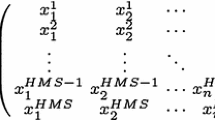Abstract
The paper presents the novel adaptive splitting and selection algorithm (AdaSS) used for learning compound pattern recognition system. Splitting a feature space into its constituents and selection of the best area classifier from the pool of available recognizers for each region are key processes of the proposed model. Both take place simultaneously as part of a compound optimization process aimed at maximizing system performance. Evolutionary algorithms are used to find out the optimal solution. The results of experiments for algorithm evaluation purposes prove the quality of the proposed approach.

Similar content being viewed by others
References
Jain AK, Duin PW, Mao J (2000) Statistical pattern recognition: a review. IEEE Trans PAMI 22(1):4–37
Chow CK (1965) Statistical independence and threshold functions. IEEE Trans Electron Comput EC-16:66–68
Krzanowski W, Partrige D (1996) Software diversity: practical statistics for its measurement and exploitation. Department of Computer Science, Raport University of Exeter
Kuncheva LI, Whitaker CJ (2001) Ten measures of diversity in classifier ensembles: limits for two classifiers. In: IEEE workshop on intelligent sensor processing, Birmingham, pp. 10/1–10/6
Xu L, Krzyżak A, Suen Ch Y (1992) Methods of combining multiple classifiers and their applications to handwritting recognition. IEEE Trans Syst Man Cybern 22(3):418–435
Kuncheva LI (2004) Combining pattern classifiers: methods and algorithms. Wiley-Interscience, New Jersey
Ruta D, Gabrys B (2005) Classifier selection for majority voting. Inf Fusion 6:63–81
Kuncheva LI, Whitaker CJ, Shipp CA, Duin RPW (2003) Limits on the majority vote accuracy in classifier fusion. Pattern Anal Appl 6:22–31
Hashem S (1997) Optimal linear combinations of neural networks. Neural Netw 10(4):599–614
Kuncheva LI, Jain LC (2000) Designing classifier fusion systems by genetic algorithms. IEEE Trans Evol Comput 4:327–336
Inoue H, Narihisa H (2002) Optimizing a multiple classifier systems. Lect Notes Comput Sci 2417:285–294
Wozniak M (2007) Experiments with trained and untrained fusers. In: Corchado E, Corchado JM, Abraham A (eds) Innovations in hybrid intelligent systems. Springer, Berlin, pp 144–150
Rao NSV (2004) A generic sensor fusion problem: classification and function estimation. LNCS 3077:16–30
Fumera G, Roli F (2005) A theoretical and experimental analysis of linear combiners for multiple classifier systems. IEEE Trans Pattern Anal Mach Intell 27(6):942–956
Biggio B et al (2007) Bayesian analysis of linear combiners. LNCS 4472:292–301
Tumer K, Ghosh J (1999) Linear and order statistics combiners for pattern classification. In: Sharkley AJC (ed) Combining artificial neural networks. Springer, Berlin, pp 127–155
Duin RPW (2002) The combining classifier: to train or not to train? In: Proceedings of the ICPR2002, Quebec City
Rastrigin LA, Erenstein RH (1981) Method of collective recognition. Energoizdat, Moscow
Baram Y (1998) Partial classification: the benefit of deferrer decision. IEEE Trans Pattern Anal Mach Intell 20(8):769–776
Cordella LP, Foggia P, Sansone C, Tortorella F, Vento M (2000) A cascade multiple expert system for verification. Lect Notes Comput Sci 1857:330–339
Giacinto G, Roli F, Fumera G (2000) Design of effective multiple classifier systems by clustering of classifiers. In: Proceedings of 15th international conference on pattern recognition—ICPR’00, vol 2, Barcelona, Spain, pp 160–163
Goebel K, Yan W (2004) Choosing classifier for decision fusion. In: Proceedings of the 7th international conference on information fusion, Stockholm, Sweden, pp 562–568
Kuncheva LI (2000) Cluster-and-selection method for classifier combination. In: Proceedings of the 4th international conference on knowledge-based intelligent engineering systems and allied technologies, Brighton, pp 185–188
Jain AK, Murty MN, Flynn PJ (1999) Data clustering: a review. ACM Comput Surv 31(3):264–323
Duda RO, Hart PE, Stork DG (2001) Pattern classification. Wiley-Interscience, New Jersey
Devijver PA, Kittler J (1982) Pattern recognition: a statistical approach. Prentice Hall, London
Higleyman WH (1962) The design and analysis of pattern recognition experiments. Bell Syst Tech J 41:723–744
Kuratowski K, Mostowski A (1996) Set theory. North-Holland Pub. Co, Amsterdam
Rokach L (2006) Decomposition methodology for classification tasks—a meta decomposer framework. Pattern Anal Appl 9(2–3):257–271
Gabrys B, Ruta D (2006) Genetic algorithms in classifier fusion. Appl Soft Comput J 6(4):337–347
Zhou ZH, Wu J, Tang W (2002) Ensembling neural networks: many could be better than all. Artif Intell 137:239–263
Duin RPW, Juszczak P, Paclik P, Pekalska E, de Ridder D, Tax DMJ (2004) PRTools4, a matlab toolbox for pattern recognition. Delft University of Technology
Siegler RS (1976) Three aspects of cognitive development. Cognit Psychol 8:481–520
Newman DJ, Hettich S, Blake CL, Merz CJ (1998) {UCI} Repository of machine learning databases. Dept. of Information and Computer Sciences, University of California, Irvine. http://www.ics.uci.edu/$\sim$mlearn/MLRepository.html
Duch W, Grudziński K (2001) Ensembles of similarity-based model. In: Advances in soft computing. Springer, Heidelberg, pp 75–85
Duin RPW, Tax DMJ, Experiments with Classifier Combining Rules, Lecture Notes in Computer Science, No. 1857, 2000, pp 16–29
Kuncheva LI, Bezdek JC, Duin RPW (2001) Decision templates for multiple classifier fusion: an experimental comparision. Pattern Recognition 34:299–314
Van Erp M, Vuurpijl LG, Schomaker LRB, An overview and comparison of voting methods for pattern recognition. In: Proc. of the 8th International Workshop on Frontiers in Handwriting Recognition (IWFHR.8), Niagara-on-the-Lake, Canada, pp 195–200
Acknowledgments
This work is supported by the grant of The Polish State Committee for Scientific Research (2006–2009).
Author information
Authors and Affiliations
Corresponding author
Rights and permissions
About this article
Cite this article
Jackowski, K., Wozniak, M. Algorithm of designing compound recognition system on the basis of combining classifiers with simultaneous splitting feature space into competence areas. Pattern Anal Applic 12, 415–425 (2009). https://doi.org/10.1007/s10044-008-0137-7
Received:
Accepted:
Published:
Issue Date:
DOI: https://doi.org/10.1007/s10044-008-0137-7




